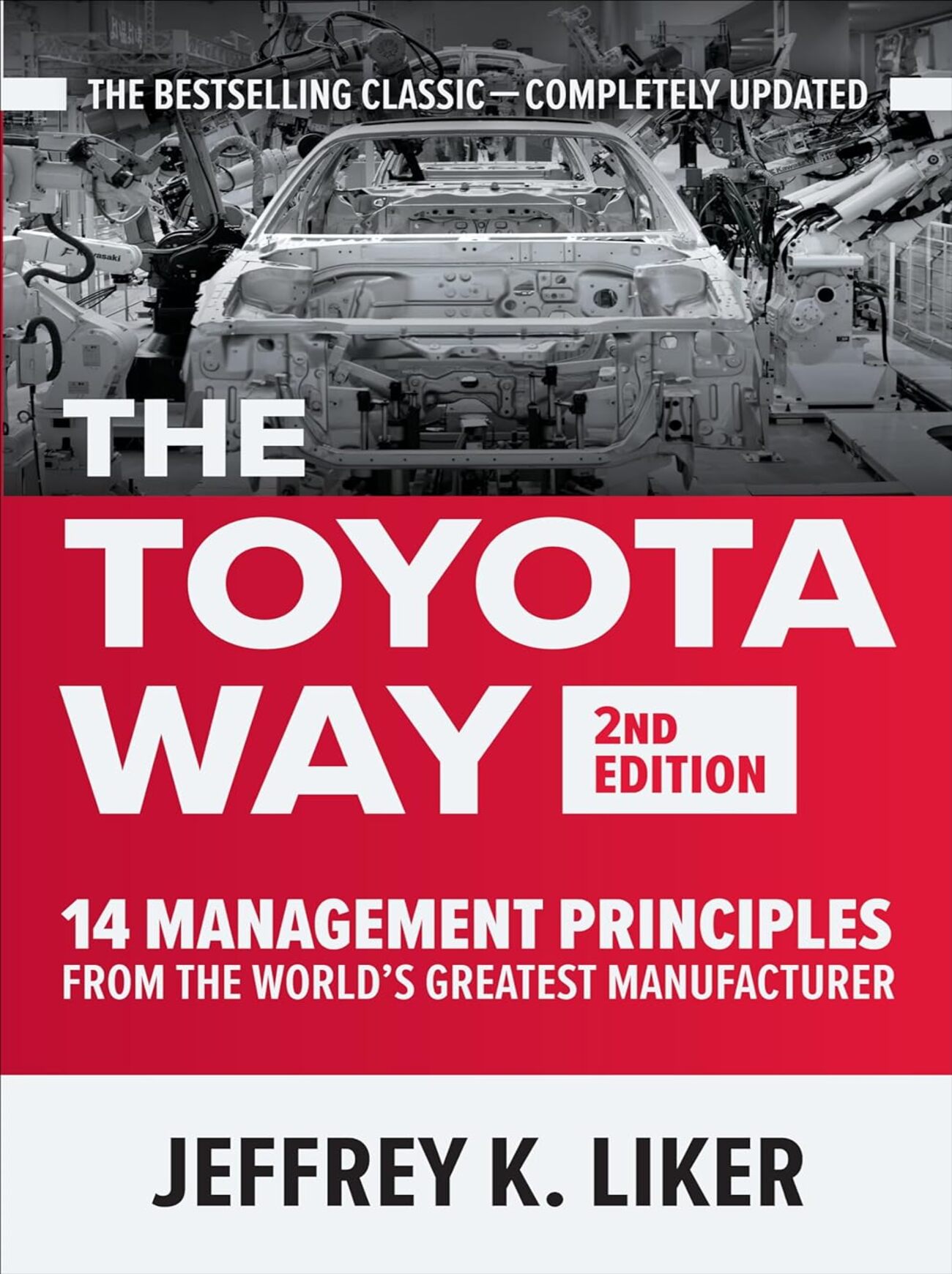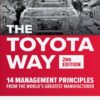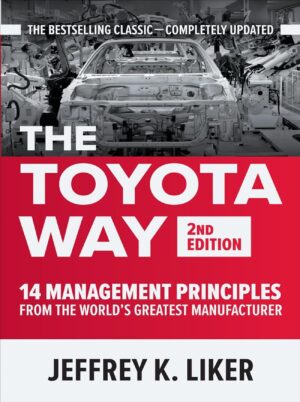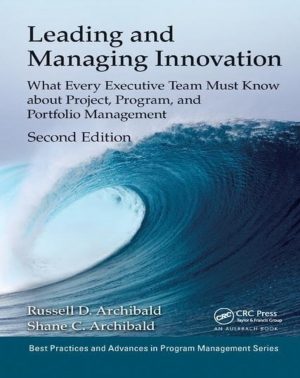The bestselling guide to Toyota’s legendary philosophy and production system―updated with important new frameworks for driving innovation and quality in your business
One of the most impactful business guides published in the 21st Century, The Toyota Way played an outsized role in launching the continuous-improvement movement that continues unabated today.
Multiple Shingo Award-winning management and operations expert Jeffrey K. Liker provides a deep dive into Toyota’s world-changing processes, showing how you can learn from it to develop your own improvement program that fits your conditions. Thanks in large part to this book, managers across the globe are creating workforces and systems that produce the highest-quality products and services, establish and retain customer loyalty, and drive business profitability and sustainability. Now, Liker has thoroughly updated his classic guide to include:
- Completely revised data and updated information about Toyota’s approach to competitiveness in the new world of mobility and smart technology
- Illustrative examples from manufacturing and service organizations that have learned and improved from the Toyota Way
- A fresh approach to leadership models
- The brain science and skills for learning to think scientifically
- How Toyota applies Hoshin Kanri, a planning process that aligns objectives at all levels and marries them to business strategy
Organized into thematic sections covering the various aspects of the Toyota Way―including Philosophy, Processes, People, and Problem Solving―this unparalleled guide details the 14 key principles for building the foundation of a powerful improvement system and managing it for ultimate competitive advantage.
With The Toyota Way, you have an inspiration and a model of how to set a direction, continuously improve and learn at all levels, continually “flow” value to satisfy customers, improve your leadership, and get quality right the first time.












Éste libro Toyota Way es una verdadera llave a tener la cultura y Grandeza de la Calidad.
Cons: not an in-depth learning of lean up for those heading down the lean path, it is a complementary book to learn additions history and ideas.
Some gems from the book:
"TPS is built on a scientific way of thinking - not a toolbox."
That's something we might have gotten utterly wrong.
"Toyota recognized that learning organizations are built on learning individuals."
In many of our organizations, we might be lacking the means to do so on a daily basis and on all levels.
"Individuals need to develop... [a scientific] ...mindset through repeated practice, with a coach."
Jeff takes us below the surface, and beyond the Lean tools, we see to explain how Toyota purposefully develops a shared mental model throughout the organization by having people practice a scientific way of thinking and acting through different formats and at different stages of their career.
What's unique? There is little classroom training. Instead, people are trained on the job, working on real projects with a manager as a coach.
Some more gems:
"Toyota didn't create a rigid problem-solving method that always has to be followed; they rather provide a framework for developing a scientific way of thinking through practice on real-world problems."
Beware the dead A3 posters covering our factory walls.
Then they trained their top management first.
"The executives, after a career of learning how to problem solve, humbly followed the process (TBP), typically over eight months, for very large issues appropriate for their level. Then, they had to report out to a board of examiners, including Fujio Cho. In about 80 percent of the cases, they were asked to go back and do some more work."
Can you believe it. C-suite managers practicing for eight months and more?
"To get to habits, we need to change behavior through deliberate practice, repeatedly. What matters is what we do, not what we think we might do. As we look at how Toyota develops people, we see that the company creates conditions that foster certain behaviors, like reducing inventory, so problems surface quickly and visibly and put pressure on problem-solving."
Creating a learning system is a top management task!
"Challenging people is not enough. The company also teaches managers how to coach—to find opportunities in the course of daily work to give corrective procedural feedback to their team members as they strive to move toward a goal."
Become a true learning organization has become a hallmark and even a necessity for 21st-century success. Jeff Liker explains how we can do so.
Great approach to a lot of things. I owned Toyota for 12 years: great quality and great service ( proof that ideas are still alive ) .
I gave it four stars because the book is occasionally lengthy even if it isn’t strictly necessary - the anecdotes might be enjoyed by others do.
Yes it is someone dated in regards its publication date however as a back story to how Toyota was born, how it managed to evolve from a small family business into the leading light of efficient, goal orientated manufacturing en mass then its a really useful book.
For a hardcover copy it's an excellent value book.
There are a number of tips and ideas within it to probably improve most workplaces without the need to pay for a lean course though it is of course no subsistute for a course.
I have marked as four stars simply because some of the information is repeated, however It gave me a new insight into such things as corporate responsibility to the community that all employers now seem to shout about in mission statements that dominate their web pages, employees come first and all employees should be allowed and encouraged to contribute to continuous improvement is actually the foundation that serves lean manufacturing.
Very good read, insight into Toyota and having a hard copy enables you to read digest and pass to a colleague or friend.
Voice is clear and the speed is just right, suitable even for non English native speakers like me.
The book has brought me to the concept of a workplace culture, which has let me to several personal breakthroughs with more to come.
Heavy on knowlege, light on understanding. The book is like reading an entire dictionary. Full of facts, full of knowlege, full of descriptions, with limited examples of each theory. It's a very long agonizing read. This is from a person who enjoys product manuals. My main critique is that the book lays out very few if any practical examples of the "principals" in use. To spite this it's still worth reading. Just like a reading an entire dictionary there are things to be learned. I could have read 1000pgs if only 600 were stories of the embodiment of the principals.
Dr. Liker has exceptional personal knowledge of Toyoda.....
Continue improvement only comes from respect for your people because they have the psychological safety to call out problems and act.
Hold philosophy or the belief system of the company sacred by respecting it in all day to day decisions
Quality, Effectiveness and Efficiency:
Quality first - If there is an issue, shut down the production line until it is fixed. There is minimal slack in the system to keep efficiency so this quickly means you’ll hold up the rest of the line so there’s high urgency to collaborating and solve. When there’s an issue, you take the time to understand the root issue.
One piece flow - progress is dependent on successful prior step, which eliminates inventory that hides defects and inefficienies
Minimize time on non-value add efforts instead of just improve efficiency on value add time. Do this by mapping out a journey of time spent.
Multiple types of waste - Even though it means less value add time, Toyota has some inventory because it enables even production so keep in mind all types of “waste”
Mixed model production - If you need to build small, medium and large trucks, enable a fast changeover so that you can level your production constantly bouncing between each truck
Management:
Bureaucracy is not necessarily bad - Documenting and demanding adherence to rules and procedures is not restricting as long as employees understand the rationale and are expected to question it when they see problems/opportunities. A strict hierarchy can still yield a learning organization that shares with one another.
Visualize controls - use the simplest way possible to demonstrate progress for all to see
Understand before you change - before trying any new technology, understand the current process with the old tech and ensure that is optimized. Then test the new tech and judge it it is better given what the company values. This makes implementation very quick and harmonious.
Deep sampling - Need to understand the details so even executives go the shop floor to watch operations and understand the detail at the level below the data. Since they have a deep understanding of the business, they can identify issues through this sampling process.
5 Whys - There is an oil spill -> a machine is broken -> the gasket has deteriorated -> the gasket is made of inferior material -> purchasing agents are evaluated on cost not performance. Unless you really dig to the root, issues will come back.
Supplier:
Demanding but loyal - Carefully select and screen suppliers by providing clear expectations at low volume. As trust is built ramp responsibility. High expectations but open in communication and providing coaching. High investment in the relationship on both sides yields real loyalty.
Dig into issues like your own business - If a supplier has an issue, Toyota analyzes every aspect of the supplier including quality planning, employee selections, training, team structure, problem solving processes, how work is standardized, relationship with their dependent suppliers. Expect reports daily, then down cadence to weekly, then down cadence to monthly
Lean:
Customer understanding - Identify who your customers are and what they care about. Famous example of head of Sienna who traveling across the US and Canada to really understand Sienna use cases.
Current State Map - process today, category time into value add vs. required non-value add (e.g. reporting) vs. waste
Future State Map - brainstorm non-value add reduction, apply 5 Whys
Implementation Plan - assign who does what by when, determine communication plan, include any necessary training
Do it - execute plan, set metrics to assess progress
Evaluate - track metrics, visualize performance, continually improve
Waste:
Muda - non value add
Muri - overburden people or equipment
Mura - unevenness
Ways to move goods:
Flow - no inventory (ideal)
Pull/Kanban - fixed inventory based on historical usage
Push - send inventory in fixed intervals (worst)
In the book Liker makes the case of lean manufacturing and the Toyota Production System which has been the cornerstone of Toyota's rise and famed quality.
The book is structured really well starting with the history of Toyota and how the Toyota Production System was created. The system itself is also well explained with its Japanese names (with English translations of course!) and which provides the way to the 14 management principles. Each management principle is described and explained with at least one case on how it helped either Toyota or another organization become more lean, improve quality and cut costs.
Overall the book is really good and explains the Toyota Production Systems well. While Toyota uses it for car manufacturing, the principles are just that, principles that can be applied to other domains. It might take a bit of thinking to see how it can be applied to another domain as the book is heavy on manufacturing cases but Liker does try and provide extra context in the last two chapter on how it can be used outside manufacturing.
I can recommend this book for the fascinating look into one of the biggest companies in the world as well as leaning about lean.
I also started to implement these teachings in day to day life and found out that some minor changes to my activities brought major changes later.
Would highly recommend to everyone irrespective of their educational background.
I would like to see more of the thinking and doing in comparison to other manufacturing systems (not just bashing other manufacturers for superficial application of the principles). But this book never pretended to be anything but the Toyota way, so no points lost there. Highly recommended!
I also Linked that there was an audio option for this.
I didn't understand lean and the managers anymore. I work for the company since 1999 and all of the sudden I was underperforming while I was doing the same job. So I started to study the lean principles.
After reading books about lean, my performance went up. I still have my job now.
This book is stunning: it is based on experiences in different plants and companies.
Learn from others mistakes so you won't make them.
Just be sure to write your name in it so that you get it back when you lend it to someone - it can get passed from person to person before you know it!
Having lived in Japan I am certainly sympathetic to this system and way of thinking but the book really helped clarify what I don't see in American and European companies & their McKinsey consultant masters.
Imballo_Giudizio: ottimo: il materiale era imballato per evitare gli urti, e nonostante uno schiacciamento i libri erano intatti
Spedizione_Giudizio: insufficiente. la confezione esterna ha subito uno schiacciamento.
giudizio in globale: ottimo il venditore. Mediocre il corriere.
I had a 2007 Toyota Camry and I doubt I would ever buy another one. It never got the gas mileage I was promised (oh yeah that was by a car lot) plus it wore out way too quickly. However, my review is on Dr Liker's book and not Toyota itself.
He clearly showed a passion for a company who on some level was committed to quality at some point. That is what you want to learn from, not from what Toyota may or may not have devolved too.
One piece flow: You can and better implement that in any business.
Reducing waste: You can and better implement that in any business.
Employee involvement: You can and better implement that in any business.
Leveling workflow: You can and better implement that in any business.
Make Mistakes: You can and better implement that in any business (or you aren't trying hard enough).
Continuous Improvement: You can and better implement that in any business (another reviewer said that its better to change lots of things, and the two are not mutually exclusive - the book says something like "queue where you have to, but otherwise get rid of queues" which would apply to changes also).
Standardized processes: You can and better implement that in any business. (This is why you go to eat at mom and pop restaurants and they are great when chef mom is there, but suck when they are off for the day.)
I have learned a lot from The Toyota Way and I have implemented some of the things and they have helped our business substantially.
Great book, the criticisms of Toyota are more than warranted, but if you are imaginative, you can use the tools in this book to help your business. Maybe you won't use all of them, but if you use 1 or 2 you will have paid for the price of this book many times over.
(If Toyota wants to improve their cars, they need to buy this book and start working at the tail which is the car dealership and bring the Toyota Way to the sales process there first, then move down the line to the factory.)
The book gives a good insight in the Toyota Production System and fully describes and explains the 14 principles. Although the Japanese words are flying around, it is easy to read and understand. This is the kind of book you want to read more than once, because there is so much in the 14 principles that we can use in our day to day life.
So if you think LEAN is only for production. Pick up this book and find out that it can be applied in many areas of our business and in our lives.
If you work for a company that claims it is "Lean" or you have been using Lean principles and have never read this - get it.
A great intro to the Lean world and the history is fascinating.
If your'e company is going Lean, read this book.
Learn what to expect. Learn what you should expect from the leader.
What you can do to help.
Or, you just want to be prepared for what seems to be the "new" way of running a buisness, a hospital, a public office, a warehouse, or a factory plant.
It's definatly not for car factory's alone.
The philosophy, bullet points and anecdotes will help you come up with ways to improve your organization.
My only criticism is that the author's adoration of the Toyota way seem to take away from, rather than add to the simple matter-of-fact principles of the topic at hand. Still, this is a book that every operational manager should read, study, and take to heart.
These days, there's a lot of talk about empowerment, and a lot of talk about leadership, and a lot of talk about what's "needed". But, there are very few manuals with as many practicable ideas and examples of success as can be found in this book. It's a book about a little car company that went from being a post-war copy-cat, to being a world leader in introducing ways to make things cheaper, value their working staff more, and in caring about their customers. I still believe that's in the core of Toyota's values, explaining why even the CEO accepts egg on his face graciously when they have made mistakes, unlike countless other side-stepping finger-pointing execs who fail to own their own mistakes as learning examples.
Read it, learn from it. And understand why North American auto workers embraced these ideas, too, when Toyota started manufacturing in Canada and the United States.
One caution: The content may appear favoring Toyodas in the begining of the book but continuing through the chapters one realizes that it is difficult to take an unbiased approach and still narrate the story!!!Enjoy
How do we take all of the concepts in the book and make them happen in our organization? One way to engage more people is to establish a Toyota Way Discussion Group or Book Club. Start with volunteer participants and meet for about an hour each week. Before the meeting, agree on the section of the book to be discussed, and ask each member to describe what it means to them and what they can do to implement the concept in their organization. They will also be able to ask for help and support from other organizations represented in the meeting. This promotes teamwork and understanding.
If any of the concepts are difficult for them to understand, have other participants explain what it means in their terms. This really promotes hands-on learning. It helps to have an experienced lean advisor available to handle the tough questions. If there are some individuals who are struggling with the concepts, this is a great process to help them understand.
Scattered throughout the text are descriptions of how and why other firms have failed to succeed in adopting lean manufacturing or "The Toyota Way". They include: lack of senior management involvement or commitment, focus on tools/techniques without an emphasis on culture, overemphasis on cost reduction, lack of discipline to sustain flow improvements, emphasis on format/rules in ISO 9000, inappropriate outsourcing, supplier abuse, and an overly narrow focus in six sigma on statistical techniques applied by experts. The book's insights and stories are valuable, but not totally persuasive.
The text provides good historical and contemporary background on Toyota's quality system and progress. It also describes and illustrates more than 30 of the quality tools and techniques in a non-technical manner. The book is well-written and well-organized, covering a massive amount of material effectively.
In addition to the many "best practices" quality techniques adopted by most Japanese and leading western firms today, Toyota emphasizes a few other management techniques which combine to make its approach unique. Within the context of "14 management principles", the author explains the value of cultural support for tools, the role of standardization as the basis for cumulative learning, the centrality of engineering and production, the use of appropriate technology, the benefits of experiential learning, the rationale for unit of one production, the role of inventory and goals in creating challenges to solve, the short-term blending of push and pull techniques, the extent of fail-safe practices, the nature of an enabling bureaucracy and the need to maintain key internal capabilities. The author does not always explain "why" these choices are necessary or exactly how they add value.
The author closes with an insightful list of "13 Tips for Transitioning Your Company to a Lean Enterprise". Dr. Liker is an unapologetic true believer in "The Toyota Way". His advice to those who do not share his commitment is the weakest part of a very highly valuable reference work on Toyota and Lean Production. "[Non-committed] top leaders should pick and choose from whatever tools are out there to improve processes for the short term, make a bundle of money, and go do something else. This is tantamount to admitting the company will never be a learning enterprise, or a great company, and it is only interested in cutting and slashing waste to look good for the short term."
It's awesome!!
This is fallacy with the Toyota Way and how it is usually presented. So many people see it as the only book to use in setting up manufacturing and it is far from that. Pick and choose from the many techniques in the book, experiment with them, and reflect with true Hanshei on what applies to your business (or garage).
If you want a high-level overview of the TPS from an outside third-party, this book might be for you. If you're looking for specifics from one of the creators of the system, _Toyota Production System: Beyond Large-Scale Production_ might be more your speed.
The Toyota Way is a good start for everybody interested in lean management in general and lean production in particular. For people in the automotive industry I think it's especially interesting and eye-opening. Unfortunately the book lacks in critical analysis of Toyota Production System, which can be quite irritating towards the end of the book. Sometimes the author is too positive about Toyota and I think he should have highlighted more of the flaws that must exist at Toyota as in any other company.
Very interesting is also the Japanese management principles and mindset - slow but determined, patient, self-reflection, learning by actuall observation and doing, consensus seeking, and managing for the long term.
By coincidence, yesterday (6/Sep/2007) the news came up that Jim Press (American Toyota President)was hired by Chrysler - I can imagine why.
Like most business books, the important stuff could have been expressed in many fewer pages. Liker almost gushes about Toyota to the extent that it somethimes reads as a vanity or promotional publication by Toyota - this makes me wonder if it really presents a balanced perspective.
Overall, I recommend it to anyone interested in Toyota or Lean.
This book is not for the Lean Champion but for the CEO, the Divisional VP, the Plant Manager, especially in those situations where Lean just has not or is not living up to the expectations.
For example, the American auto companies are still in business long after Japanese cars surpassed American cars in quality -- so the American companies must have done something right, too, like inventing the minivan and SUV markets. Therefore, there's got to be some strategic shortcomings of The Toyota Way.
Another example... the book's case study of the new Sienna minivan is not such a shining example, in my opinion. The chief engineer has to drive across North America to discover the advantage of having multiple cup holders??? American cars/vans have had that feature for years! He had to observe the loading of wood planks into a Honda Odyssey to be convinced for the large body size??? Then "The Honda Way" was already better than "The Toyota Way", and in any case, all American vans/trucks have had the size advantage for decades! Besides, reading an issue of The Consumer Report magazine could give you the same info. So, the question is not how "The Toyota Way" helped discovering those good features in the car, but why it took so long?
Despite the above, I think this is a great book that clearly articulated The Toyota Way from technique to philosophy. Recommended!
Pro:
+ Shows Toyota's commitment, i.e. the willingness to pursue perfection everyday forever (which is why I think so many fail... satisfied with good)
+ Provides building blocks upon which to build lean systems and apply lean tools
+ Philosophy is quite detailed while avoiding "tools" (they are a distraction from successful business transformation)
Con:
- Not a recipe for you to copy... no shortcuts or cutting corners here
- Does not directly describe principles and concept behind hoshin kanri (strategic planning) - I really would have liked this
- Does not include any "kata" - now viewed as a key element for cultural transformation
- A bit lengthy
Bottom line: Recommended for serious lean zealots only. I think that this book is true to the philosophies of Toyota as I've directly observed from the 4 or 5 different senseis (former Toyota executives turned consultants) I have had the chance to work with. Revised July, 19, 2012 due to recent advancements in the study of Toyota.
For the American boss, if you want to implement TPS( Toyota production system ), then you need to change the working culture in your organization.
As a boss , if you think you are not the type of person as indicated in this book (like to dirty your hands ) and you want to implement TPS ; Get a General Manager who have the determination to implement TPS , give him full responsibility to implement.
As a word of caution , employing a TPS consultant will only survive as long as the consultant is around, once the consultant left, the working culture will be back to its original form .
The chapters on the development of the Lexus and Prius are particularly compelling. Toyota's holistic development approach offers all industries a fine example of how product development should be done.
The bigger benefit, though, is that this book catalogs the root from which a lot of the Lean and Agile work in the software development community has taken its cues. In that conversion to software, some of the fundamental pieces, like jidoka (stopping to fix problems to get quality right the first time) have largely been lost, as have many of the more philosophical principles that supported the long-term success. If you're building your own process cocktail and are already fairly well-versed in Scrum, Crystal, XP, DSDM, and FDD, this is a great book to pick up to make sure you haven't lost some of the overarching philosophy.
The book has a visible structure that the reader can use to zoom in on topics of interest. Fourteen principles are stated upfront, and then a chapter is devoted to each of these principles. The writing is clear, and many outside sources are acknowledged with a thoroughness that is uncommon in business books. In particular, 28 Toyota executives are acknowledged or quoted, which gives the book the flavor of an authorized rendition of the company's philosophy.
The book's greatest strength, the closeness of the author to the company's management, is also its main limitation. As an academic, the author could have assumed a less worshipful stance. For example, rather than taking management statements about wanting to do right for society as a whole at face value, he might have pointed out that they sound like obligatory recitations of Confucian values, and that it is arguable that flooding the world with cars is in the best interest of the human race. Also, without attacking the company, he could have made its portrayal more nuanced and vivid by including more points of view, such as those of line workers and former employees who may have a different perspective than current top managers.
The executives quoted in the book clearly feel that the philosophy is more important than the technical tools of the production system. This insight, however, has come to them as a result of using the tools intensively for many years, and the reader should not be misled into thinking that it is possible to bypass the tools and go straight to the philosophy.
I also have a few minor quibbles with the way the book is produced. The fourteen chapters covering the fourteen principles have numbers that don't match those of the principles, so that, for example, Principle 6 is covered in Chapter 12. This is confusing when looking up cross references. The subject of this book also calls for abundant illustrations, but there is only one for every seven pages, and no photographs. Finally, I think that the use of long words where short ones would do should be identified as the 9th category of waste. We don't need to hear about a "paradigm," As Tom Wolfe's hero in "A man in full" points out, the only thing it ever does is shift. Saying "non-value-added waste" where "waste" would suffice also strangely suggests that there might be an opposite called "value-added waste."
All this being said, this book is a good read based on intimate knowledge. I recommend it to anyone involved with lean, and particularly to managers and engineers in the auto parts industry who want to sell their products to Toyota.
The approach is typically American, always comparing between mass production & TPS and thus showing merits of TPS. I would have liked an approach that does not compare with mass production, but with other lean companies ( Author has done this to some extent, to be frank with you all).
May be there is a lot of people around who believe in mass production and author has to take the message across to them also.
Whatever said and done, this book is unique because of it's holistic approach to Toyota Way.
I would suggest the following to enjoy the book better.
1. Do not think that Toyota Way is not only for Business, it can be applied effectively in day to day life.
( Try to apply the Sphagetti diagram when you are preparing your tea next time, you will see a lot of ways to improve the way you make tea!)
2. Do not get carried away by the examples given. Take a paper run your imagination and try to get a real life picture.
3. Try to apply each principle in Simple day to day real life process. Read through the Book once. come back review and read the book again.
In a nutshell "Feel the Toyota Way, dont just try to read it".
All Best for a good experience with Toyota Way.
He would have been better illustrating the underlying principles of the toyota way by way of more real case studies outside of toyota but then as we know few have managed to emulate this secret sauce. Of course those who use and practice the toyota way everyday come to understand that the tools are a much smaller part than most writers would lead you to believe.
Because of this I would only recommend some passages to my clients / students, and avoid advising them reading the full book at the start of a lean transformation as would confuse most embarking on the lean enterprise strategy.
Only one big beef with the book...
I was terribly dissappointed by the product development case stories which actually contradicted many of the arguments presented and the principles espoused. Engineers informing spouses that they have to go and live in the plant is the overburden that toyota is supposed to deplore with a vengence and then to the waste....anyone can throw "hundreds of engineers" to a project. These elements of the book made me question how much value adding was really going on in these examples. So I ultimately questioned the accuracy of the reporting. Cynically I began to question the "one big room process" must have been a really really really big room! Did Mr liker really have access to toyota'product development process? In addition the mythical "18month development time for a new car" was not correct. From blank sheet of paper to new car in the Prius case cited was actually many years from the goals being set. This part was just plain hype. Sure Toyota 'productionises' their cars very quickly and undoubtedly their design re-use levels make for very high quality, but mostly bland designs. From blank sheet of paper to new car in 18 months? No way.
So in summary one of the better books on the subject. Only marred by a clumsy structure and over hyping in area's that could have done with more factual case studies than anecdotes. I suggest that the book on toyota's product development is yet to be really written. The lexus story is now a decade old and, in europe at least, lexus has not really achieved its aspirational brand goals.
The toyota way is an interesting read on the toyota phenomenon but like most things about toyota you only truly learn by doing.
The toyota way claims on its jacket to enable you to be like toyota. As a sensei I'll finish with a question....
Can we play like tiger woods after reading his book?
Chris Cooper
(...)
Top Ten Gems of the Book, Letterman-style:
10. 13 Tips for transitioning to a lean enterprise
9. The Ford Cuautitlan plant used web-based hoshins
8. The A3 and effective meetings
7. "Independent Contract Services" cannot be charged to a TTC purchasing credit card
6. The K4
5. Mediating the water dispute
4. Ford Vision, Toyota Vision
3. Eiji's inspiring Briton
2. TSSC benchmarks the Shingo Award sensor firm
1. Hansei
Go buy it now or buy several for ad hoc distribution.